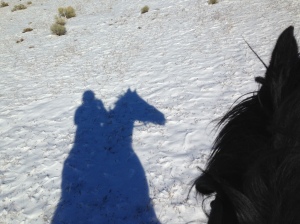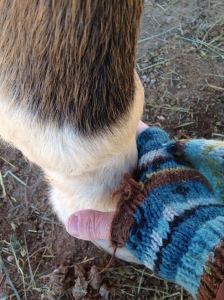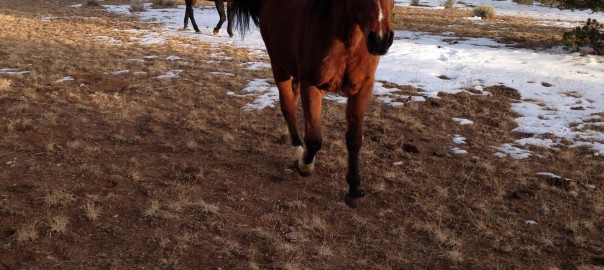In my previous post, I talked about physical exercises for horses during winter, to avoid “wild and crazy horse behavior.” In this post I’d like to talk about using bodywork to support your horse at any time, but I think it’s very appropriate right now, when movement is difficult for horses because of the footing and the cold weather.
Recently I’ve worked on many horses who have had deficient circulation because they have not been able to move around as much, and equally importantly, they don’t drink as much water. According to a study at the University of New Hampshire on people, during cold exposure, vasoconstriction takes place – the body decreases blood flow to the periphery of the body to decrease heat loss. “Because blood volume at the body’s core increases, the brain does not detect blood volume decrease. Thus, the fluid balancing hormone AVP is not secreted at the same increased rate, despite elevated blood sodium. The kidneys get a diminished signal to conserve fluid, and thirst sensation is reduced by up to 40 percent.”
 This also happens with animals, because there is less stimulus to drink water than in hot weather. It’s really a trade off because the body feels the necessity to maintain its core temperature at the risk of fluid imbalance and dehydration. That’s why we may first feel cold in our hands and feet. The result of this core warmth is decreased circulation or vasoconstriction. Some horses also colic during the cold weather, largely because not enough moisture is finding its way into the gut and they are susceptible to dramatic barometer changes.
This also happens with animals, because there is less stimulus to drink water than in hot weather. It’s really a trade off because the body feels the necessity to maintain its core temperature at the risk of fluid imbalance and dehydration. That’s why we may first feel cold in our hands and feet. The result of this core warmth is decreased circulation or vasoconstriction. Some horses also colic during the cold weather, largely because not enough moisture is finding its way into the gut and they are susceptible to dramatic barometer changes.
Horses with laminitis, insulin resistance or Cushings may be more prone to lack of circulation in general, and the winter can create more stress for them.
Making sure horses have enough water to drink is definitely important, but also keeping it warmer can help. An electric water heater or a solar water heater can keep the tanks from freezing and ice forming. You can add a small amount of apple juice or cider to a bucket of water to make it more appealing to the reluctant drinker. Keep an eye on your horses’ urine – it should be clear and is a good indicator of whether they are drinking enough.
![[Catherine Sobredo Photography]](https://horsesatliberty.files.wordpress.com/2012/08/imgp2225-edit.jpg?w=300)
It does take a trained eye to notice if a horse is stiff and not moving properly, but people who have owned a horse for awhile can also tell if their horse isn’t moving right and if he needs some additional help. One way to tell if the circulation is okay is to press on the area above the coronary band, in the fur, and feel for indentations there. If there are indentations, there is a deficiency and the blood flow is not getting to the hooves as effectively as it could. By holding these spots very gently, you can increase the blood flow back into the hooves and legs.
If your horse is shod, consider removing the shoes for the winter. Metal shoes conduct cold (as well as heat) up the limbs and can cause incredible discomfort and possible damage to the horse in the winter. Shoes themselves restrict circulation, and they can cause unnecessary slipping on ice and snow as well, and ice build up or “snowballs.”
 Think about it – blood flow is particularly important to the limbs for horses because they stand on all fours, they have contact with the frozen ground. Humans have the ability to put their legs up the wall (consider this for yourself!) to increase and change circulation, as well as we lie down for longer periods than horses. In yoga, being upside down is stressed as being really important to change the direction of circulation. Clearly, we can move our extremities in far more ways than horses can.
Think about it – blood flow is particularly important to the limbs for horses because they stand on all fours, they have contact with the frozen ground. Humans have the ability to put their legs up the wall (consider this for yourself!) to increase and change circulation, as well as we lie down for longer periods than horses. In yoga, being upside down is stressed as being really important to change the direction of circulation. Clearly, we can move our extremities in far more ways than horses can.
Sometimes people don’t get bodywork for their horses during the winter because it means that they may have to stand outside in the cold to hold their horse. But often I work on the horse while the person sits in their warm house. It also is a time when people shut down, throw the hay in the feeder and scoop as much frozen poop as possible, but then get back inside. But it really benefits the horse hugely to have this work continued throughout winter. Otherwise, when spring comes, some health issues may appear suddenly that weren’t there before. It could take some time to resolve them then, when actually it would be nice to begin riding again.
I am running a series of OrthoHorse Tutorials beginning in 2014, to show people how to do some elementary care for their own horses. Let me know if you are interested; the first one is on January 18th at Arrowhead Ranch in Santa Fe. (info below). Happy New Year!
****
Services: Bodywork (Ortho-Bionomy for people, Equine Positional Release/Equine Ortho-Bionomy): private sessions (including Horse & Rider sessions), tutorials, phone consultations, distance healing communication and gift certificates
Liberty Training: clinics, mini-clinics, workshops, private and semi-private sessions, tutorials, consultations: by appointment: 505.501.2478 or emailing susansmith@orthohorse.info Winter Lessons – semi-private, private and small group sessions. Scheduling now. Contact me for details.
New on the schedule for 2014:
January 18, OrthoHorse Tutorial – Arrowhead Ranch, Santa Fe, Susan Smith, Advanced Registered Practitioner Ortho-Bionomy 9:30 a.m.-12:30 p.m. FULL. 1:30-4:30 p.m. OPEN.
February OrthoHorse Tutorial (Times TBA)
March 1-2 Horses at Liberty Foundation Training Weekend Clinic, DeLand, Florida. Contact Anne Daimler, tdaimler@cfl.rr.com (386-822-4564) or myself for registration and information. Space is limited. OrthoHorse Tutorial also offered before the clinic: February 28 (see flyers below). An afternoon Tutorial may be offered by popular demand.
April 5-6 Spirit Horse Ranch Liberty Foundations Clinic, Jones Oklahoma, Presented by trainers Ruella Yates and Susan Smith. Contact Ruella Yates ruella@libertyfoundations.com, (405-771-4274) or myself for registration and information. Space is limited.





What a timely post for me, Susan, and I suspect it will be for many people! My pony will benefit from your advice!
For the Horse,
Ruella Yates
Thanks, Ruella, I do hope it’s helpful for others as we all grapple with this early cold this year! Hugs to you and Starwyn! Susan